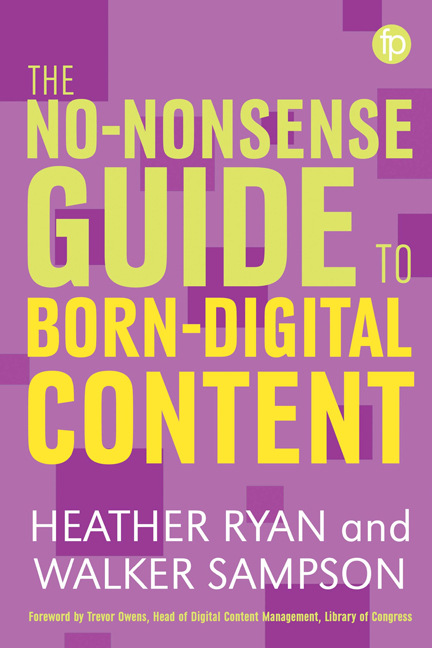Book contents
- Frontmatter
- Contents
- List of figures and tables
- Foreword
- Acknowledgements
- List of abbreviations
- Glossary
- Introduction
- 1 Digital information basics
- 2 Selection
- 3 Acquisition, accessioning and ingest
- 4 Description
- 5 Digital preservation storage and strategies
- 6 Access
- 7 Designing and implementing workflows
- 8 New and emerging areas in born-digital materials
- Conclusion
- References
- Appendix A Resources
- Appendix B Basic Unix command line prompts
- Index
7 - Designing and implementing workflows
Published online by Cambridge University Press: 08 June 2018
- Frontmatter
- Contents
- List of figures and tables
- Foreword
- Acknowledgements
- List of abbreviations
- Glossary
- Introduction
- 1 Digital information basics
- 2 Selection
- 3 Acquisition, accessioning and ingest
- 4 Description
- 5 Digital preservation storage and strategies
- 6 Access
- 7 Designing and implementing workflows
- 8 New and emerging areas in born-digital materials
- Conclusion
- References
- Appendix A Resources
- Appendix B Basic Unix command line prompts
- Index
Summary
No, Watson, this was not done by accident, but by design.
(Sir Arthur Conan Doyle, The Adventures of Sherlock Holmes)A series of actions needs to be taken to address the management and access of born-digital materials in an institution – or more precisely, you need to put all of the processes that we have discussed up to this point together somehow. When archivists and librarians discuss that series of actions, they typically refer to it as a workflow. Workflows may address any – and potentially all – aspects of the institution's responsibilities vis-à- vis born-digital collection materials.
The benefits of creating and using workflows are many. Workflows illustrate a unified and principled handling of born-digital materials, and clearly articulate that to staff and trainees. Workflows can also function as a record of what actions the institution performs for its materials. To that end, workflows need not be static references, but living documents; an ongoing project, capable of being amended or adjusted as conditions change.
A note on tools
We find that perhaps the best benefit of workflows is the adjustment in analytical and strategic thinking. Workflows allow you to draw out ideas in a more visual or impromptu manner, and even to incorporate spatial logic into your document (e.g. important steps have larger shapes and more minor steps have smaller outlines) if you care to do so. Even if you do not prefer a visual representation, quickly jotting down your lists and steps is a good break from formal writing. In other words, a key benefit is the opportunity to ‘think on paper’ in a different way than you might were you to draft a report or policy.
There are many software tools available to create visual workflows, and many of these conform to the Unified Modeling Language (UML). UML is a shared schema of shapes and visual cues to indicate a great deal of the logic you may either find or want to display in a workflow: decision points, relationships and dependencies, among numerous others. While there is certainly a place for this level of formalism and interoperability, we suggest that you disregard it as you begin creating workflows. The best tool will be the one which gets out of your way, and for many that will be paper and pencil or marker and whiteboard.
- Type
- Chapter
- Information
- The No-nonsense Guide to Born-digital Content , pp. 153 - 164Publisher: FacetPrint publication year: 2018



